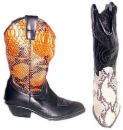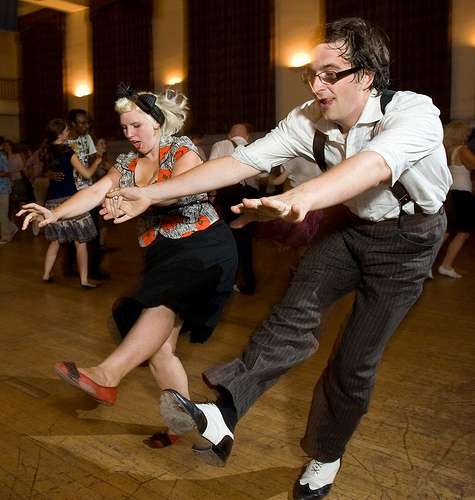|
|
 |
LINE DANCING
If you have never tried this before, please be patient – it will probably take a few weeks before you
start to feel you are making any progress. Imagine learning a new song. It takes time, and practice, before you know the tune and all the words by heart. Learning a dance is just the same.

Picture of Line dancing boots above
In line dancing some of the steps come in groups, each with its own name.
Don't worry! Once you have a grasp of the basic moves, learning new dances
will become easier
There are over 20,000 line dances so we can only ever expect to know a few.
They all have varying degrees of difficulty and speed. Some are written
for one piece of music, others can be danced to many different tracks. Some tracks
can be used for different dances. Some dances taught are popular at local clubs
so that if you want to join one, or attend a social event, you'll be able to join in.
Line Dancers are very friendly and you'll always find someone who’s happy to guide a novice.
It is also very good for you, physically, mentally and spiritually. It
can help keep joints supple and build up strength in your leg muscles; it's good for the heart & lungs; memorising the
step patterns exercises your brain; and it is GOOD FUN! Line dancing is supported
by a number of medical charities including British Heart Foundation and National Osteoporosis Society.
Clothing: Lots of layers –
tops, t-shirts, shirts. When you exercise you get warm, when you sit down you
get cold. Be prepared!
Refreshment: You can become quite dehydrated during physical exercise and it is a good idea to
get a drink whenever you need one.
IMPORTANT!
(Health and Safety): - If there are any moves that cause pain or dizziness, steps can easily be adapted so that you
can still learn and enjoy the dances
Taken
from a list as prepared by Deana Randle (Fully Qualified BWDA Linedance Instructor and Qualified Further and Adult
Education Teacher)
|
 |
|
And (&) / Syncopation |
A step made on the half-beat (e.g. One-And-Two, i.e. 3 steps over two beats). This is called syncopation. E.g. triple step or syncopated grapevine: side, behind, side-cross, touch (1, 2, &3, 4)
|
|
BPM |
Beats per minute. All
music can be timed for its speed. Many dances fall between 100 and 140 bpm. Under 100 and the dance will often feel slow and flowing, above 140 and it can be
a bit of a race. |

Beats per minute picture above
|
Clock |
When turning to face different directions, either
at the end of each wall ready to start again or during each repetition of steps, it is usual to use the numbers on a clock
face as a guide. The front wall is 12 o’clock, the wall on your right is
3, the back wall is 6, the one on your left is 9 from your starting position at the
beginning of the dance.
|
|
Count |
A dance is usually described as a (number)-count
dance e.g. 32-count / 64-count, etc. One count is one beat of the music.
|
|
Walls |
A dance is described by its number of “Walls”. A 1-wall dance only ever restarts the pattern of steps facing the front wall; a 2-wall
dance starts at the front wall then the back wall in turn; a 4-wall dance starts its repetition facing each wall of the room
in turn. NB: it doesn’t matter
how many turns are put into the dance, which cause you to face any number of walls during the dance, what is important is
the direction you’re facing when the whole pattern restarts from Count 1.
|
|
Tag |
An additional number of steps or moves (usually only a very few)
that allows the music to catch up before both dance and music can start again at what feels to be the correct point.
|
|
Vanilla & Chocolate |
If you dance precisely to the script this is called “Vanilla”. If you like to add your own extra moves or styling (completely acceptable), this is
called “Chocolate”. Example – instead of a vine, do a rolling
vine; instead of a coaster step, do a triple full turn. |
|
 |
|
|
 |
|
|
 |
|
|
|
|
SOME COMMON MOVES USED IN LINE DANCING
You
will encounter many of these moves in the first range of dances you learn. There
are a few others but most of those will only be found in more advanced dances.

Picture of the Charleston step above
|
Move |
Description |
|
Charleston steps |
Movement of 4 counts: Point, step, point, step
1. Point 1st foot forward, 2. Step 1st foot back in place, 3. Point 2nd foot
BACK, 4. Step 2nd foot forward in place
|
|
Chassé |
Movement of three steps: Side-together-side. (Or side-close-side.)
*Can be to left or to right. *Can either be done over three counts or two using '&' beat (e.g. 1&2).
|
Move |
Description |
|
Coaster step |
Movement
of three steps: Back-together-forward.
1. Step back on 1st foot, 2. Step back on 2nd foot, 3. Step forward on 1st foot.
*Can be done with left or right foot leading. *Can either be done over three counts two or using '&' beat (e.g. 1&2).
|
|
Dig |
Touch the heel forward (no weight)
|
|
Hitch
|
To raise knee of specified (non-supporting) leg. |
|
Jazz box |
Movement of four steps: Cross-back-side-forward.
*Usually done over four counts, with one step
on each beat. *Can be done with either right or left foot leading. (Think of Hank Marvin and the Shadows!!!).
|
|
Kick ball change
|
Three
movements in two beats (i.e. 1&2)
1. Kick specified foot forward, 2.
Step weight onto same foot, 3. Step weight onto other foot.
|
|
Lock step |
Movement
of three steps: Step-lock-step. (Similar
to a VINE done on a diagonal direction.)
1. Step forward, 2. Bring second foot up crossing BEHIND first foot, 3. step first
foot forward again.
*Can be done with left or right foot leading. *Can either be done
over three counts two or using '&' beat (e.g. 1&2). *Can be done forwards
or backwards.
|
|
Mambo step |
Movement
of three steps:
1.
Step 1st foot in specified direction and rock weight onto it; 2. Recover weight onto 2nd foot; 3. Return
1st foot to starting position.
* Can be done forwards, backwards, or sideways.
|
|
Monterey turn |
Movement of four counts: Point-turn-point-together.
1. Point toe out to side, 2. Return foot to centre transferring weight over, at the same time making turn of
specified length and direction, 3. Point other toe out to side, 4. Return foot to centre transferring weight over (no turn).
*Can be done with left or right foot leading.
|
|
Pivot turn |
Movement
of two counts: Step-turn.
1. Step first foot forward, 2. Make turn (½ or ¼
as indicated) and transfer weight onto second leg in direction of second leg. E.g. To make a right pivot turn: Step left foot forward, make turn to right as you replace your
weight onto right foot.
|
|
Rocking Chair |
Movement of 4 steps: Forward, back, back, forward
1. Rock forward on 1st foot, 2. Rock back on 2nd foot, 3. Rock BACK on 1st
foot, 4. Rock forward on 2nd foot
|
Move |
Description |
|
Rumba box |
Movement over 8 counts producing a square pattern. Can be done
with either foot leading and in a clockwise or anti-clockwise direction.
|
|
Sailor step |
Exaggerated coaster step.
1. Step 1st foot behind 2nd foot. 2. Step
2nd foot diagonally forward. 3. Step 1st foot to side
of 2nd foot.
|
|
Scissor steps |
Movement of 3 steps:
1. Step 1st foot to side, 2. Step 2nd foot next to 1st foot, 3. Cross step
1st foot over in front of 2nd foot.
*Can be done over 4 counts
(1,2,3 hold) or syncopated on 1&2.
|
|
Shuffle |
Movement
of three steps (similar to a lock step):
1. Step forward, 2. bring second
foot up BESIDE first foot, 3. step first foot forward again.
*Can be done with left or right foot leading. *Can be done over three counts or using '&' beat (e.g. 1&2). *Can be done forwards backwards or sideways (see chassé).
|
|
Strut |
Movements done over two counts:
Heel strut: 1. Place heel
of indicated foot forward, 2. drop toe to floor.
Toe strut: 1. Place toe of indicated foot onto floor, 2. drop heel to floor.
* Toe struts can be done forwards, backwards or
sideways.
|
|
Triple step |
Three steps over two counts (e.g. 1&2):
1. Step onto first foot, 2. step onto second foot, 3. return to first foot.
* Done on the spot (not travelling in any direction). * Can be done with left or right foot leading.
|
|
Vine
(grape-vine) |
Sideways movement of 4 counts: Side-behind-side-X. (Travelling in direction indicated, 1. step first foot to side, 2. step second foot behind first, 3. step
first foot to side, 4. 'X' can be scuff/stomp/brush/hitch/touch etc.)
|
|
Waltz |
3 beats to the bar, i.e. the pattern of the dance has 3 counts to each group rather than the usual 4.
Basic = forward or backward.
Step on count 1, weight change on 2 & 3.
Twinkle = cross over on count 1, weight change on 2 & 3. |
 
|
|
|
 |

